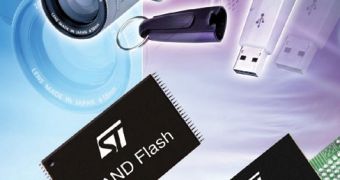Intel and Micron announced their newest breakthrough that will dramatically improve the NAND flash-memory data transfer rates by up to five times than the nowadays technology. This is not a theory or a project anymore, as Micron rolled out its first working devices built on the new discovery. The interface specification is fully compliant with the Open NAND Flash Interface (ONFi) Working Group.
The ONFi group was formed back in 2006 and counts more than 71 members. The latest NAND standard is the ONFi 2.0 specifications set that delivers data transfer rates of up to 133 megabytes per second. The asynchronous interface can only "push" 50 MB/s and is merely maintained in order to preserve the backwards compatibility with older devices.
According to Kevin Kilbuck, director of market development for NAND flash memory at Micron, the new interface will solve the performance bottlenecks in the NAND storage. As Intel and Micron have a NAND manufacturing venture (IM Flash Technologies), their products will be the first to take advantage of the new discovery.
"The computing market is embracing NAND-based solutions to accelerate system performance through the use of caching and solid-state drives," said Pete Hazen, director of marketing for Intel's NAND Products Group.
The new technology allows NAND devices transfer data at up to 200-MB/s for reading and 100-MB/s for writing. The current devices on the market can only deliver 40-MB/s while reading and less than 20-MB/s for writing. This will drastically cut down transfer times between NAND-based devices such as cell phones, MP3 players or digital cameras.
"At up to five times the performance over conventional NAND, the high-speed NAND from Intel and Micron, based on the ONFi 2.0 industry standard, will enable new embedded solutions and removable solutions that take advantage of high-performance system interfaces, including PCIe and upcoming standards such as USB 3.0," he said.
This joint achievement will allow the storage industry to experiment with hybrid disk-drives that will read and write up to four times the initial speed. Micron has already released an 8 Gb single-level cell (SLC) storage disk for its OEM partners, that is built with the 50-nanometer processing node. The disk will start mass production in the second half of 2008, with a multi-cell version to arrive the next year.

 14 DAY TRIAL //
14 DAY TRIAL //